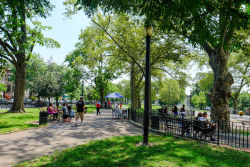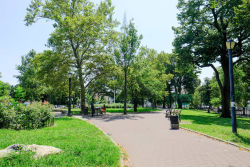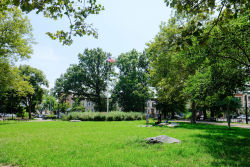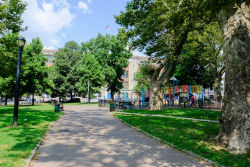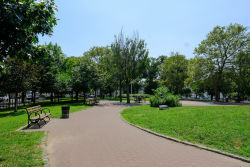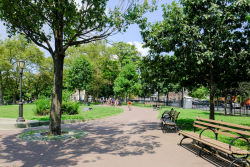Irving Square Park
Irving Square Park
What was here before?
Margaret E. Duryea owned this land during the 1800s. A descendant of Joost Duryea, along with his wife Magdalena Le Febre, emigrated from Mannheim, Germany, in the late 17th century. Both were French Huguenots who had sought refuge from religious persecution. They initially settled in New Utrecht, now part of Brooklyn, in 1675 and later moved to Bushwick in the 1680s.
The Duryea family played a role in the development of Bushwick, Brooklyn, over the centuries, particularly as the neighborhood evolved during the 19th and early 20th centuries.
How did this site become a park?
In 1895 Kings County purchased this parcel from Henry Roth and his wife for $70,000 or about $265,000 in 2025. The following year, the county developed the park by grading and planting the landscape, laid curving paths and enclosed the site with an iron picket fence. Three years later the City of Brooklyn and the County of Kings were incorporated into the City of New York. In 1905 a brick shelter with bluestone trim was erected in the center of the park.
Parks installed playground facilities including swings, sandpit, spray shower, and handball and basketball courts in 1958. Six years later, the agency added a new recreation building, additional playground equipment, and landscaping. The playground moved to the eastern part of Irving Square in 1985, and the former play area was converted into a seating area with a stage. Between 2006 and 2008 two major projects completely renovated the park and playground and added a public plaza and garden area. Irving Square Park now features antique style gates, a small performance space and a regraded central lawn with evergreens and flowers. A compact prefabricated public restroom building was added in 2025.
What is this park named for?
The likely honoree of this park is Washington Irving (1783-1859), an influential American writer, known for his short stories, essays, and historical works.
Born in New York City, he studied law but soon pursued a literary career. Irving gained fame with A History of New York under the pseudonym Diedrich Knickerbocker, a name that now refers to both Dutch descendants in New York and the New York Knicks basketball team.
After his fiancée's death, Irving spent 17 years in Europe, where he wrote The Sketch Book, which includes the iconic tales "Rip van Winkle" and "The Legend of Sleepy Hollow." He later worked for American embassies and wrote on Spanish history, including works about Columbus and the Alhambra.
Irving returned to New York in 1832, becoming the first American author with international recognition. He wrote A Tour of the Prairies and other works before settling in Irvington, New York. He also served as U.S. Minister to Spain from 1842-1846. He passed away in 1859 at his estate, Sunnyside, in Tarrytown.
Check out your park's Vital Signs
Clean & Safe
Green & Resilient
Empowered & Engaged Users
Share your feedback or learn more about how this park is part of a
Vital Park System

